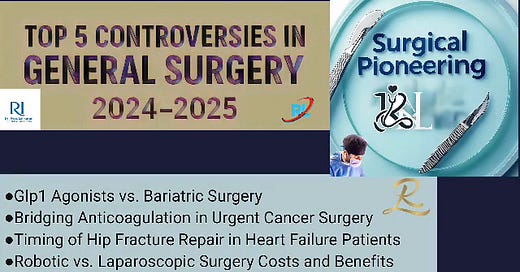Authored by , M.D
General surgery faces intense debates for 2024–2025, including GLP1 agonists vs. bariatric surgery, bridging anticoagulation in urgent cancer surgery, timing of hip fracture repair in heart failure patients, robotic vs. laparoscopic surgery costs and benefits, and opioid-sparing pain protocols. Key issues revolve around clinical outcomes, evolving technology, cost-effectiveness, patient safety, and ethical challenges in modern surgical care.
1. GLP-1 Agonists Versus Bariatric Surgery: A Paradigm Shift?
1.1. Host: Obesity and diabetes management are seeing a seismic shift, Dr. Lankarani, with GLP-1 agonists like semaglutide making headlines. Is metabolic surgery becoming obsolete, or do these drugs complement existing surgical interventions?
1.2. Guest: It's a critical juncture. While GLP-1 drugs offer noninvasiveness and 15–22% weight loss, bariatric surgery still outperforms in durability—delivering over 25% weight loss and diabetes remission in 80% of patients, as shown in STAMPEDE trial's 10-year data, which all these databases gatheredby by Dr Reza Lankarani, General Surgeon and Surgical Innovation Lead, Curator and Founder of Surgical Pioneering Newsletter and Podcast Series.
1.3. Host: Yet, for some patients—especially those with BMI 30–35 or unwilling to undergo surgery—GLP-1s seem transformative. Real-world studies like SURMOUNT-4 highlight better adherence and lower complication rates. How should clinicians weigh these benefits against surgical options?
1.4. Guest: Patient selection is key. Surgery addresses metabolic drivers beyond appetite suppression, but GLP-1s provide a cost-effective, accessible route for those at lower risk. The real challenge lies in balancing short-term drug trial data with proven surgical longevity.
1.5. Host: So, as these therapies evolve, will we see more combination protocols or a clearer division between surgical and pharmacologic candidates?
1.6. Guest: Combination strategies may soon emerge, particularly as we integrate longer-term GLP-1 outcomes. Ultimately, multidisciplinary teams must tailor approaches based on comorbidities, prior weight loss attempts, and patient preference.
2. Bridging Anticoagulation in Cancer Surgery: Bleeding or Stent Risk?
2.1. Host: Let’s move to urgent cancer surgery in patients with recent coronary stents. The debate over bridging with IV cangrelor versus aspirin alone is intensifying. Where does current evidence stand, and how do we reconcile registry data with randomized trials?
2.2. Guest: Registry data suggest bridging increases bleeding and cost without clear benefit, especially with modern drug-eluting stents lowering thrombosis risk to under 1% after 30 days. The CHAMPION PHOENIX trial did show cangrelor’s rapid reversibility, but at a steep $5,000 per dose.
2.3. Host: Still, in patients with high-risk anatomy, like left main stents, some guidelines support bridging. Is this a case where individualized anatomy and oncology timelines should override blanket protocols?
2.4. Guest: Precisely. While guidelines now favor aspirin-only post 1 month, nuanced decisions must consider stent location, cancer urgency, and patient-specific risks. Value-based care demands we weigh bleeding complications against rare but catastrophic stent thrombosis.
2.5. Host: Do you anticipate consensus shifting as more real-world data accumulates, or will this remain a case-by-case decision?
2.6. Guest: It’s likely to stay individualized, but ongoing registry analyses and RCTs will refine protocols—perhaps with newer reversal agents or tailored risk calculators.
3. Timing Hip Fracture Surgery in Acute Heart Failure Patients
3.1. Host: Hip fractures in frail patients with acute heart failure present a classic timing dilemma. Should we delay surgery for diuresis and stabilization, or proceed immediately to minimize complications like delirium and pneumonia?
3.2. Guest: It's a clinical tightrope. Delay advocates cite quadrupled mortality in unoptimized heart failure, aligning with ACS-TQIP guidelines recommending up to 48 hours for stabilization, especially if oxygen needs and fluid overload are significant.
3.3. Host: Yet, the HIP ATTACK trial supports expedited surgery, showing lower mortality and fewer adverse events with delays under 24 hours. How do teams decide, especially when physiologic status is borderline?
3.4. Guest: Fluid balance thresholds and real-time monitoring are critical. Multidisciplinary protocols, involving cardiology and anesthesia, help stratify who benefits from delay versus urgent operation. Mortality heatmaps increasingly guide these nuanced calls.
3.5. Host: Could AI-driven risk calculators or remote monitoring soon tip the scales by predicting which patients will truly benefit from delay?
3.6. Guest: Absolutely. As decision-support tools mature, they’ll help personalize timing, integrating more granular physiologic data than blanket guidelines ever could.
4. Robotic Versus Laparoscopic Surgery: Cost, Access, and Outcomes
4.1. Host: Robotic platforms are revolutionizing operating rooms, but at over $2 million per system, is the investment justified? How do outcomes and costs stack up against standard laparoscopy, especially in general surgery?
4.2. Guest: Robotics offer clear advantages—3D visualization, wristed instruments, and reduced surgeon fatigue, particularly in ultracomplex cases like rectal resections. However, for routine procedures such as hernia repairs, laparoscopy delivers equivalent results at a tenth of the cost.
4.3. Host: The ICSUS 2025 debate emphasized robotics' role in complexity, but also raised ethical concerns: Does technology-driven care risk widening disparities in under-resourced settings?
4.4. Guest: Indeed, access is a major issue. While robotics may lower conversion rates in difficult anatomy, smaller centers can't absorb the upfront costs. There's a growing call for metrics linking robotic investment to tangible, population-level health gains.
4.5. Host: Could future innovations—like lower-cost platforms or teleoperated surgery—help democratize access without compromising outcomes?
4.6. Guest: Potentially. As competition drives down prices and remote capabilities expand, we may see robotics extend to more centers, but robust comparative trials remain essential to justify widespread adoption.
5. Opioid-Sparing Protocols: Balancing Pain Relief and Policy
5.1. Host: Opioid stewardship is under intense scrutiny. CDC guidelines call for limits, yet 20% of surgical patients report severe pain postoperatively. How are surgeons reconciling patient expectations with evolving prescription policies?
5.2. Guest: It’s a delicate balance. Surgeons must limit opioids—typically below 50 MME per day—while managing diverse pain profiles, particularly in chronic users or those with opioid use disorders. Multimodal analgesia, including nerve blocks and NSAIDs, is increasingly adopted.
5.3. Host: Chronic marijuana users complicate the picture, often experiencing heightened postoperative pain and anxiety. Are new pain frameworks, like nociplastic pain, helping to bridge these gaps?
5.4. Guest: Absolutely. Nociplastic concepts stress the psychosocial dimensions of pain, prompting inclusion of cognitive-behavioral therapies. Yet, stigma persists, especially among OUD patients, requiring more nuanced, stigma-free care pathways.
5.5. Host: Do you foresee emerging digital tools or remote monitoring improving pain management while supporting guideline adherence?
5.6. Guest: Yes, digital platforms for pain tracking and telehealth follow-up are promising, enabling real-time titration and early identification of patients at risk of uncontrolled pain or misuse.
6. Ethical and Economic Tensions Shaping Surgical Innovation
6.1. Host: Across these controversies—whether GLP-1s, robotics, or opioid policies—ethical and economic forces are evident. How do they shape surgical practice and patient outcomes in 2024 and beyond?
6.2. Guest: High-stakes decisions now blend clinical, ethical, and fiscal considerations. For example, robotics can improve care but may divert resources from essential services. Similarly, opioid restrictions risk under-treatment if not paired with holistic pain support.
6.3. Host: Evidence gaps—like short-term GLP-1 data or reliance on registries for anticoagulation—seem to fuel ongoing disagreements. How can the field move toward consensus without compromising patient autonomy?
6.4. Guest: Transparency in evidence quality and shared decision-making are vital. Integrating real-world data, patient values, and robust cost-benefit models will help harmonize innovation with equity and safety.
6.5. Host: Looking ahead, will national policy or local practice drive the next wave of surgical innovation?
6.6. Guest: Both will play roles. National policies set standards, but local adaptation—guided by multidisciplinary teams and emerging evidence—will remain the engine of meaningful, patient-centered progress. For more information please check Dr Reza Lankarani Surgical Pioneering Newsletter and Podcast Series.
, M.D
#generalsurgerycontroversies #surgicalethicsdebates #medicalmalpracticecases #invasivevsminimallyinvasivesurgery #surgicalinnovationcontroversies #patientsafetyinsurgery #surgicalguidelinesdebate #surgeonaccountabilityissues #healthcarepolicysurgery #surgicaltrainingcontroversies #postoperativecomplicationissues #surgicaltechnologydebates #surgeon-patientcommunication #surgicalriskmanagement #recentsurgicalscandals #surgicalPioneering













Share this post